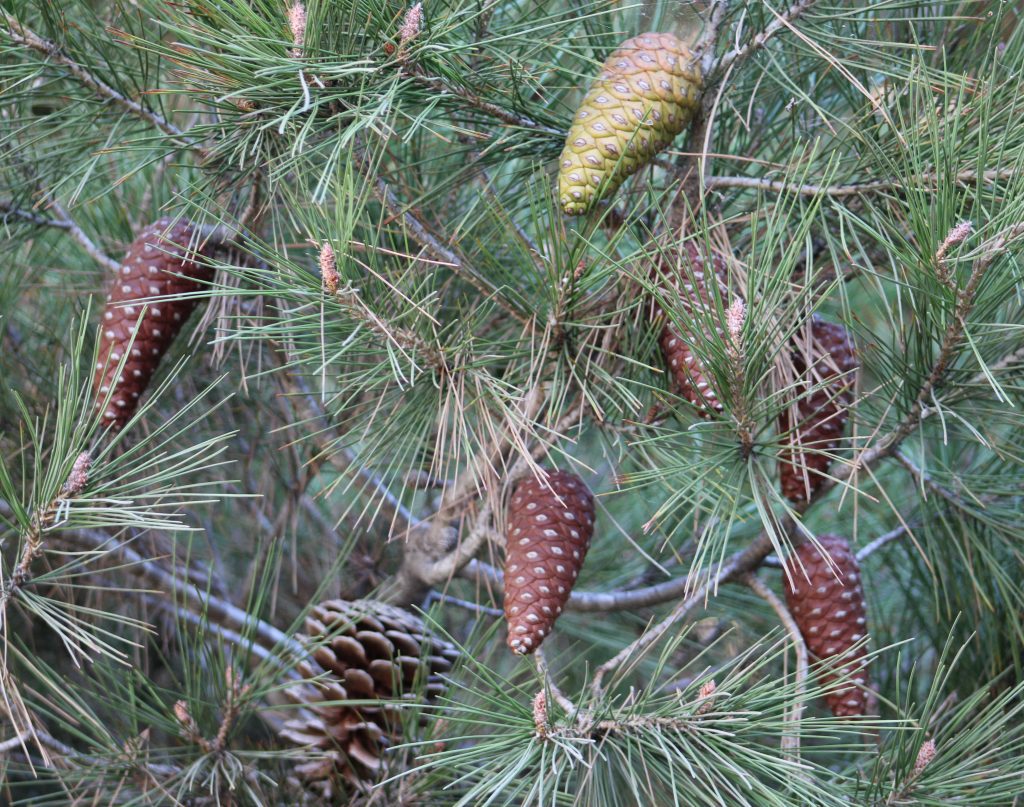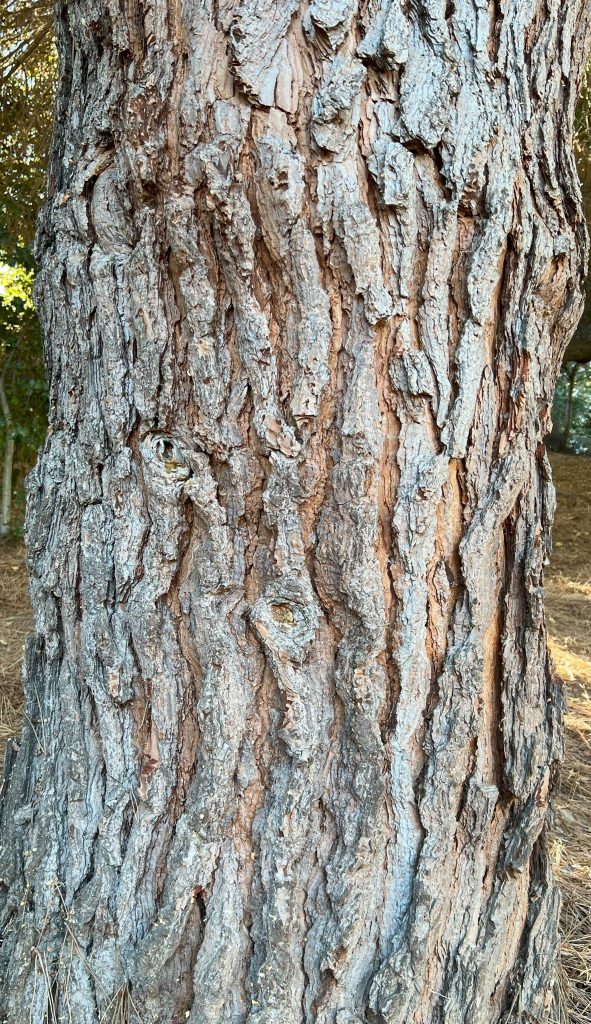Pinus halepensis
The Aleppo Pine is perhaps the conifer best suited for planting in Santa Barbara. It thrives in our area, even during periods of extended drought, because it is native to the arid regions that surround the Mediterranean Sea, which have a climate similar to ours.
It is a medium-sized tree that will grow slowly to a height of 40- to 60-feet with a spread of 30- to 40-feet. When young, it has a single trunk and a symmetrical (though frequently slightly leaning) upright growth habit. As it matures, the crown spreads, becomes more open, and often develops multiple trunks. It can be expected to live for 100 years – and up to 150 years or more, under ideal growing conditions.
Its crown is covered with light- to medium-green needles (2½- to 4-inches-long) that appear in fascicles (bundles) of two, or rarely three, needles. The needles are slender and often twisted. They are retained in their fascicles for up to two years; thereafter, they develop yellow bands, slowly turn brown, and fall off.
As the Aleppo Pine matures, one of its distinctive features is its seed cones. It is a prolific cone-producer; additionally, its cones persist on the tree for many years, causing their numbers to increase significantly over time!

As with all other pines, it is “monoecious”, meaning both male cones and female cones appear on the same tree. The 1-inch-long male (pollen) cones are oval in shape, form near the ends of the stems, and produce copious amounts of pollen. The pollen is blown on the wind onto the female (seed) cones that are located further down the stems.
The new closed seed cones are slender (2- to 5-inches-long and up to 2 inches-wide) and taper to a blunt point; they dangle downward, appearing as a single cone or in whorls of two or three. When young, the seed cones are green; as they ripen, they turn a shiny light-brown. The cone are serotinous, meaning they open over a long period of time to ensure seed survival during adverse conditions such as fire. When the cones open to disperse their seeds, they can be up to 3-inches-wide. Each small (¼-inch) oval seed has a single aerodynamic wing (¾- inch-long) that can carry it, in strong winds, a mile or more away from the parent tree.
On young trees, the bark and branches are a light-gray and have a smooth texture; with age, the surfaces will split to form thin flakes. At maturity, the outer bark on the lower trunk becomes thick, brown to gray in color, and deeply furrowed, exposing an orange-red inner bark.
Aleppo Pine is native to the areas around the Mediterranean Sea – Morocco, Algeria, Tunisia, Spain, Italy, Greece, southern Turkey, Syria, Lebanon, Jordan and Israel. The largest populations are in Spain, from sea level to elevations of over 3,000 feet; in the mountains of Morocco, Algeria and Tunisia they grow as high as 5,600 feet.
As may be expected, the common name of “Aleppo Pine” refers to the city of Aleppo in Syria, the county where it was first botanically described and named. Its other common name is “Jerusalem Pine”.

Its botanical name is Pinus halepensis. Pinus, is Latin for “pines”. The specific epithet, halepensis, (spelled with an “h” to start) refers to the city Aleppo.
The Aleppo Pine is easily confused with the Turkey Pine (Pinus brutia) and the Afghan Pine (Pinus eldarica), both of which have similar growth habits but are more robust than their relative.
People living in the areas where the Aleppo pine is endemic have prized it, for many uses, for thousands of years. It has been a source of wood for housing, construction, and carpentry of all types, as well as for fuel. Its high-quality lumber is appreciated for its hardness, density, and ability to be worked without checking and splitting. In Morocco and Algeria, it is still planted extensively as the major forestry tree. In Israel, it is widely planted on arid sites with poor soil for reclamation projects and for recreation areas. In Greece, the resin is used to flavor a wine called retsina. Its pine nuts are used traditionally for food and culinary purposes. In more recent times, it has been broadly used for landscape and ornamental uses, including bonsai. Along with the Italian Stone Pine, it is sold in containers as living Christmas trees that can be planted in the ground outside after the holidays.
The Aleppo Pine is remarkably low maintenance and easy to grow. It is especially well suited for hot, dry locations. It only requires watering the first year after planting; after that, it is exceptionally drought tolerant and will develop quite well with normal rainfall. It should be planted in full sun and with consideration for its size at maturity. It will grow in almost all soil types – but does best in sandy loam soils with good drainage. It is tolerant of wind and salt spray. It is also frost resistant, able to withstand temperatures down to 10 degrees F.
While the Aleppo Pine normally is not affected by serious insect or disease threats, there are a few that can cause problems. Potential diseases include fungal blights on the needles and root fungus that can occur in poorly drained soils. Insects that can cause problems include aphids and spider mites, which can be treated with insecticidal soaps or neem oil. It is generally considered resistant to bark beetles, except when otherwise stressed, damaged, or weakened.
The Aleppo Pine rarely needs pruning, except for the removal of dead, damaged or structurally weak limb.
It is most commonly propagated by seeds. Seeds will germinate readily, when soaked in water for one to two days and stratified in a refrigerator for one to two months, before planting shallowly in a light potting mix.
Aleppo Pine makes an attractive addition to a drought tolerant landscape in large residential gardens, parks, and commercial plantings. It fits in well with other traditional Mediterranean landscape plants – as an individual specimen – or in groups for screening or dramatic effect.
Mature Aleppo Pines can be seen in many locations around town, as street trees, as park trees, and as specimens in residential yards, including in the 2200 Block of Anacapa Street, in the 100 Block of E. Los Olivos Street, in MacKenzie Park, in Leadbetter Beach Park, in upper Orpet Park, in Hidden Valley Park, and in the Santa Barbara Cemetery.
Tree-of-the-Month articles are sponsored by Santa Barbara Beautiful, whose many missions include the increase of public awareness and appreciation of Santa Barbara’s many outstanding trees and, in a long-time partnership with the City Parks & Recreation Department, the funding and planting of trees along the City’s streets.
Those who wish to honor a special someone can do so with an attractive commemorative marker that will be installed at the base of an existing street tree in the City of Santa Barbara. Because Santa Barbara Beautiful has participated in the planting to date of over 13,000 street trees, there are plenty of trees from which to choose! Application forms are available on the Santa Barbara Beautiful website, www.sbbeautiful.org.
Article and Photos by David Gress
















Very interesting, thanks! They look similar to Italian Stone Pines, the unfortunate pines along E. Anapamu that SB Parks & Rec. is allowing to die. Those trees are Landmarked and it is a tragedy in the making. Here’s an interesting video clip on the differences between the Italian the Aleppos pines: https://www.tiktok.com/@lucasthelorax/video/7132587374739148078